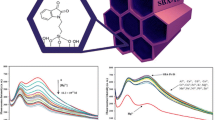Abstract
Terbium silica hybrid material with imidazole ring that can be emissive in water has been designed and showed host-guest interactions with specific ions (cations and anions). In detail, we studied the sensing abilities of this material by addition of the anions H2PO -4 , HSO -4 , F-, Cl-, Br- and I- to water suspension of the derived powders. Only dihydrogen phosphate resulted in the quenching of the lanthanide luminescence (detection limit 10-5 M). The same way was found in Cu2+ ions which also gave rise to luminescence quenching (detection limit 10-5 M). More interestingly, luminescent sol-gel films were successfully prepared by the same materials and exhibited emission responses to H2PO -4 and Cu2+. For the sake of improving its mechanical property, the robust and flexible inorganic/PMMA hybrid material with sensing capability was also developed for future use.






Similar content being viewed by others
References
Robertson A, Shinkai S (2000) Cooperative binding in selective sensors: catalysts and actuators. Coord Chem Rev 205:157–199. doi:10.1016/S0010-8545(00)00243-5
Kataoka Y, Paul D, Miyake H, Shinoda S, Tsukube H (2007) A Cl− anion-responsive luminescent Eu3+ complex with a chiral tripod: ligand substituent effects on ternary complex stoichiometry and anion sensing selectivity. Dalton Trans 2784-2791. doi:10.1039/b703944a
Gale PA, Quesada R (2006) Anion coordination and anion-templated assembly: Highlights from 2002 to 2004. Coord Chem Rev 250:3219–3244. doi:10.1016/j.ccr.2006.05.020
Anzenbacher JP, Jursı´kova´ K, Sessler JL (2000) Second generation calixpyrrole anion sensors. J Am Chem Soc 122:9350–9351, 10.1021/ja001308t
Pfeffer FM, Buschgens AM, Barnett NW, Gunnlaugsson T, Kruger PE (2005) 4-Amino-1, 8-naphthalimide-based anion receptors: employing the naphthalimide N-H moiety in the cooperative binding of dihydrogenphosphate. Tetrahedron Lett 46:6579
Pfeffer FM, Frederick M, Seter M, Lewcenko N, Barnett NW (2006) Fluorescent anion sensors based on 4-amino-1, 8-naphthalimide that employ the 4-amino N-H. Tetrahedron Lett 47:5241
dos Santos CMG, Ferna′ndez PB, Plush SE, Leonard JP, Gunnlaugsson T (2007) Lanthanide luminescent anion sensing: evidence of multiple anion recognition through hydrogen bonding and metal ion coordination. Chem Commun 3389–3391. doi:10.1039/b705560a
Zeng Q, Cai P, Li Z, Qin JG., Tang BZ (2008) An imidazole-functionalized polyacetylene: convenient synthesis and selective chemosensor for metal ions and cyanide. Chem Commun 1094-1096. doi:10.1039/b717764j
Caltagirone C, Hiscock JR, Hursthouse MB, Light ME, Gale PA (2008) 1, 3-Diindolylureas and 1, 3-diindolylthioureas: anion complexation studies in solution and the solid state. Chem Eur J 14:10236–10243. doi:10.1002/chem.200801639
Bunzli J-CG, Piguet C (2005) Taking advantage of luminescent lanthanide ions. Chem Soc Rev 34:1048–1077. doi:10.1039/b406082m
David P (2000) Luminescent lanthanide sensors for pH, pO2 and selected anions. Coord Chem Rev 205:109–130. doi:10.1016/S0010-8545(00)00241-1
Murray NS, Jarvis SP, Gunnlaugsson T (2009) Luminescent self-assembly formation on a gold surface observed by reversible ‘off–on’ switching of Eu(III) emission. Chem Commun 4959–4961. doi:10.1039/B909938G
Nonat AM, Harte AJ, S′en′echal-David K, Leonard JP, Gunnlaugsson T (2009) Luminescent sensing and formation of mixed f–d metal ion complexes between a Eu(III)-cyclen-phen conjugate and Cu(II), Fe(II), and Co(II) in buffered aqueous solution. Dalton Trans 4703–4711. doi:10.1039/b901567a
Yamada T, Shinoda S, Tsukube H (2002) Anion sensing with luminescent lanthanide complexes of tris(2-pyridylmethyl)amines: Pronounced effects of lanthanide center and ligand chirality on anion selectivity and sensitivity. Chem Commun 1218–1219. doi:10.1039/b202822k
Tsukube H, Onimaru A, Shinoda S (2006) Anion Sensing with Luminescent Tris(β-diketonato)europium(III) Complexes and Naked-Eye Detection of Fluoride Anion. Bull Chem Soc Jpn 79:725–730
Mahajan RK, Kaur I, Kaur R, Uchida S, Onimaru A, Shinoda S, Tsukube H (2003) Anion receptor functions of lanthanide tris(β-diketonate) complexes: naked eye detection and ion-selective electrode determination of Cl- anion. Chem Commun 2238–2239
Binnemans K (2009) Lanthanide-Based Luminescent Hybrid Materials. Chem Rev 109:4283–4374. doi:10.1021/cr8003983
Liu FY, Fu LS, Wang J, Liu Z, Li HR, Zhang HJ (2002) Luminescent hybrid films obtained by covalent grafting of terbium complex to silica network. Thin Solid Films 419:178–182
Wang QM, Yan B (2004) Novel luminescent terbium molecular-based hybrids with modified meta-aminobenzoic acid covalently bonded with silica. J Mater Chem 14:2450–2454. doi:10.1039/b402667e
Dong DW, Jiang SC, Men YF, Ji XL, Jiang BZ (2000) Nanostructured Hybrid Organic-Inorganic Lanthanide Complex Films Produced In Situ via a Sol-Gel Approach. Adv Mater 12:646–649
Acknowledgements
Q. M. appreciates National Natural Science Foundation of China (21002035) and talent fund provided by Guangdong Province (No. C10208).
Author information
Authors and Affiliations
Corresponding author
Electronic supplementary material
Below is the link to the electronic supplementary material.
ESM 1
(DOC 2391 kb)
Rights and permissions
About this article
Cite this article
Tan, C., Zheng, Y., Wang, Q. et al. Recognition of H2PO -4 and Cu2+ in Water by Luminescent Terbium Silica Xerogel. J Fluoresc 21, 1117–1122 (2011). https://doi.org/10.1007/s10895-010-0787-x
Received:
Accepted:
Published:
Issue Date:
DOI: https://doi.org/10.1007/s10895-010-0787-x




